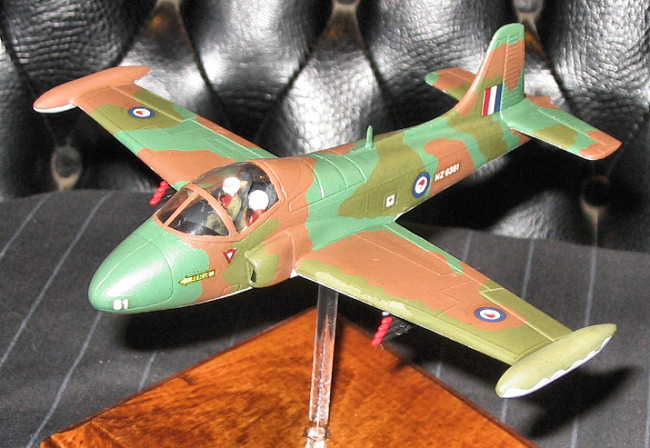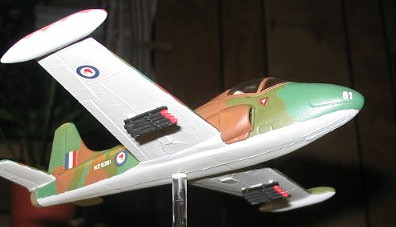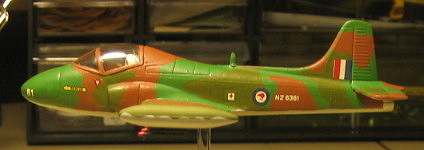
Matchbox 1/72 Strikemaster 80/88
| KIT #: | PK-10 |
| PRICE: | CDN$10.00 |
| DECALS: | Two options |
| REVIEWER: | Alex Murray |
| NOTES: | A nice little kit |

| HISTORY |
I have been in the
hobby off and on since about five years of age. Iím a terrible
procrastinator and have always intended to submit some of the models that I
have completed, but with part time University studies and the like always
seeming to be in the way it  took until now to finally submit my first
model. I could say Iím not new to the hobby, but certainly have a ways to
go to improve my hobby skills to the level of ďDa BossĒ and the many fellow
hobbyists on ModelingMadness.
took until now to finally submit my first
model. I could say Iím not new to the hobby, but certainly have a ways to
go to improve my hobby skills to the level of ďDa BossĒ and the many fellow
hobbyists on ModelingMadness.
Since Mark Fordham has already done an excellent history write-up for the Strikemaster, Iíll take the easy way out and simply repeat verbatim, the history that Matchbox provided with the kit:
ďA new aircraft, incorporating the rugged simplicity of the Jet Provost Mk. 4, but able to carry nearly 4 times the armament load, over a wider radius of action. The 167 issued by a number of airforces as a close support ground attack machine and by the R.A.F. for pilot training. Two machine guns are fitted to the fuselage and 8 underwing attachment points provide for the carriage of bombs, rockets, fuel tanks etc. the side-by-side seating greatly assists in trainingĒ.
| THE KIT |
This kit is typical Matchbox with simplistic details, ease of construction and multiple colours molded in free of charge, wow! I have to confess I like all things Matchbox since they were my first models when growing up as a kid during the 70ís, I also had (and still do) have an extensive collection of Matchbox cars (my mom somehow or other never got around to throwing them out), ha ha.
This kit must have been a copy of the original as I didnít get the standard Matchbox stand that usually came with their original models. The kit comes with the option to make either a Royal New Zealand Air Force version or a Royal Saudi Arabian Air Force version, I chose the former as I liked the paint pattern better as well as the fact that I wanted to add a Kiwi Air force plane to my collection.
| CONSTRUCTION |
 I prefer to build
my models straight out of the box. I havenít crossed the threshold to
buying aftermarket resin add-ons and the like, but I have a sneaking
suspicion that the threshold may no doubt be crossed in the foreseeable
future. As usual, I started with the cockpit (which is very Spartan to say
the least). I painted the entire interior flat black to hide the lack of
detail but decided to include the pilots as I still have a strange affinity
for including pilots in my models. The fuselage halves were then glued
together and the wings and elevators etcetera also glued on. Since I did
the model wheels up, the gear doors were then glued on as well. Once this
was finished, I masked the canopy with Tamiya tape and started painting.
I prefer to build
my models straight out of the box. I havenít crossed the threshold to
buying aftermarket resin add-ons and the like, but I have a sneaking
suspicion that the threshold may no doubt be crossed in the foreseeable
future. As usual, I started with the cockpit (which is very Spartan to say
the least). I painted the entire interior flat black to hide the lack of
detail but decided to include the pilots as I still have a strange affinity
for including pilots in my models. The fuselage halves were then glued
together and the wings and elevators etcetera also glued on. Since I did
the model wheels up, the gear doors were then glued on as well. Once this
was finished, I masked the canopy with Tamiya tape and started painting.
I have decided to do most 1/72 models wheels up and 1/48 wheels down, so I therefore built a stand for the B.A.C. Strikemaster. The stand was made from a base of pine bought from a local art store, then stained with Antique Chestnut. I then drilled a hole using a 13/64 drill bit for both the model and base and inserted acrylic rod. I think in retrospect that next time Iíll use a smaller gauge of acrylic rod as the acrylic rod is a bit too thick for the average 1/72 model.
I have to mention that after having taken pictures of the Strikemaster that Iím glad Iím finally learning the ďartĒ of puttying and fully intend to put it to good use. The seams are glaringly obvious, but I suppose this is all part and parcel of learning and improving my modeling skills.
| COLORS & MARKINGS |
 As stated above, I
decided to go with the RNZAF markings and decals that Matchbox provided
with the kit. The Strikemaster was built before I purchased my Iwata
Airbrush so the entire model was painted by hand. I hand brushed the model
using Testors enamels. The main colours used were Mat Army Olive, Mat Olive
Drab Green, Military Brown and RLM 63 Licht Grau for the undersides. I
donít think any of these colours are all that accurate, but close enough.
The more beer I consumed, the more the colours became accurate, ha ha.
As stated above, I
decided to go with the RNZAF markings and decals that Matchbox provided
with the kit. The Strikemaster was built before I purchased my Iwata
Airbrush so the entire model was painted by hand. I hand brushed the model
using Testors enamels. The main colours used were Mat Army Olive, Mat Olive
Drab Green, Military Brown and RLM 63 Licht Grau for the undersides. I
donít think any of these colours are all that accurate, but close enough.
The more beer I consumed, the more the colours became accurate, ha ha.
After spraying the entire model with Testors Gloss, the Kiwi decals that came with the kit went on surprisingly easy. Considering the age of the model I was quite happy about this. I did the Matchbox Fairey Seafox before and I donít even want to talk about how crummy those decals were (splintered everywhere). The Strikemaster was then sprayed with Testors Flat to seal the decals in.
| CONCLUSIONS |
 I really enjoyed
putting this kit together. Although Tamiya/Hasegawa kits eclipse Matchbox
in just about every facet, I still enjoy building old school models such as
Matchbox, Monogram, Airfix etcetera more for some reason. The kit was easy
to build, easy to paint and with some work and better knowledge then mine,
turns out to be a nice looking plane. Iíd definitely recommend this kit to
anyone interested in a fun simple build of an interesting British jet.
I really enjoyed
putting this kit together. Although Tamiya/Hasegawa kits eclipse Matchbox
in just about every facet, I still enjoy building old school models such as
Matchbox, Monogram, Airfix etcetera more for some reason. The kit was easy
to build, easy to paint and with some work and better knowledge then mine,
turns out to be a nice looking plane. Iíd definitely recommend this kit to
anyone interested in a fun simple build of an interesting British jet.
Before I forget, many thanks to the people I bugged on this site for advice and tips, its much appreciated.
February 2006
| REFERENCES |
Donald, David. The Encyclopedia of World Aircraft. London, England: Brown Packaging Books Ltd. 1997. ISBN 1-85605-375-X
(And of course google.com)
Alex Murray
If you would like your product reviewed fairly and fairly quickly, please contact the editor or see other details in the Note to Contributors.